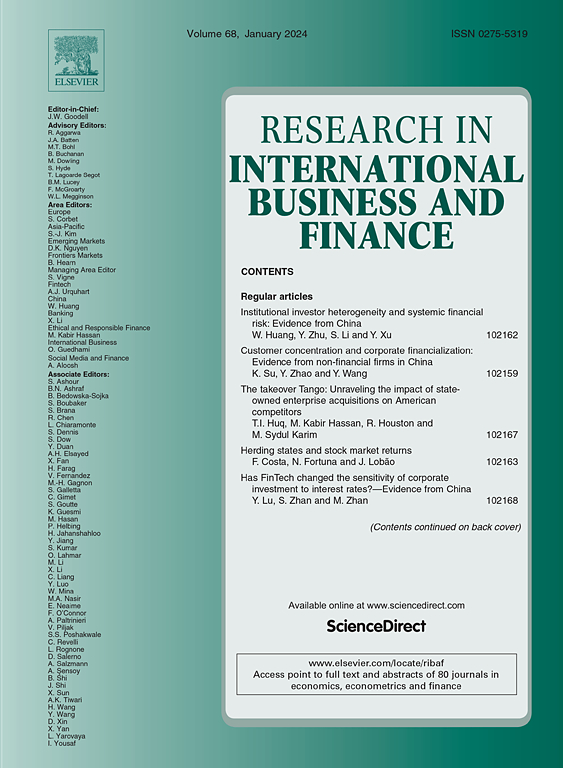Investor sentiment and market returns: A multi-horizon analysis
IF 6.3
2区 经济学
Q1 BUSINESS, FINANCE
Research in International Business and Finance
Pub Date : 2025-02-01
DOI:10.1016/j.ribaf.2024.102701
引用次数: 0
Abstract
This study explores the relationship between investor sentiment and market return in the stock market, spanning both long-term and short-term horizons. Using a decade-long dataset (2013–2023) from Facebook, comprising around 773,000 curated posts from an initial 900,000, the research employs the Vector Error Correction Model (VECM) to illuminate long-run dynamics, revealing an equilibrium-restoring mechanism post-shocks between investors’ sentiment and Vietnamese stock market index (VNIndex). Short-term insights emerge from logistic and quantile regression analyses, categorizing market returns based on sentiment and elucidating relationships across market return distribution quantiles. The study also applies advanced machine learning algorithms—such as Decision Tree Regression (DTR), Support Vector Machine (SVM), Neural Networks (NN), Gradient Boosting Machine (GBM), Random Forest (RF), and Deep Neural Networks (DNN)—to demonstrate the predictive power of sentiment indices in forecasting abnormal returns on the VNIndex. The results emphasize the paramount influence of investors’ sentiment in terms of its predictive power compared to traditional autoregressive models of past trading data. Distinct patterns arise when comparing the low and high quantiles of returns distribution, with sentiment indicators being more influential at the lower quantiles. In summary, the research underscores the significant role of investor sentiment in the Vietnamese stock market dynamics and highlights the confluence of sentiment analysis and modern machine learning as a promising frontier in financial research.
求助全文
约1分钟内获得全文
求助全文
来源期刊

Research in International Business and Finance
BUSINESS, FINANCE-
CiteScore
11.20
自引率
9.20%
发文量
240
期刊介绍:
Research in International Business and Finance (RIBAF) seeks to consolidate its position as a premier scholarly vehicle of academic finance. The Journal publishes high quality, insightful, well-written papers that explore current and new issues in international finance. Papers that foster dialogue, innovation, and intellectual risk-taking in financial studies; as well as shed light on the interaction between finance and broader societal concerns are particularly appreciated. The Journal welcomes submissions that seek to expand the boundaries of academic finance and otherwise challenge the discipline. Papers studying finance using a variety of methodologies; as well as interdisciplinary studies will be considered for publication. Papers that examine topical issues using extensive international data sets are welcome. Single-country studies can also be considered for publication provided that they develop novel methodological and theoretical approaches or fall within the Journal''s priority themes. It is especially important that single-country studies communicate to the reader why the particular chosen country is especially relevant to the issue being investigated. [...] The scope of topics that are most interesting to RIBAF readers include the following: -Financial markets and institutions -Financial practices and sustainability -The impact of national culture on finance -The impact of formal and informal institutions on finance -Privatizations, public financing, and nonprofit issues in finance -Interdisciplinary financial studies -Finance and international development -International financial crises and regulation -Financialization studies -International financial integration and architecture -Behavioral aspects in finance -Consumer finance -Methodologies and conceptualization issues related to finance
 求助内容:
求助内容: 应助结果提醒方式:
应助结果提醒方式:


